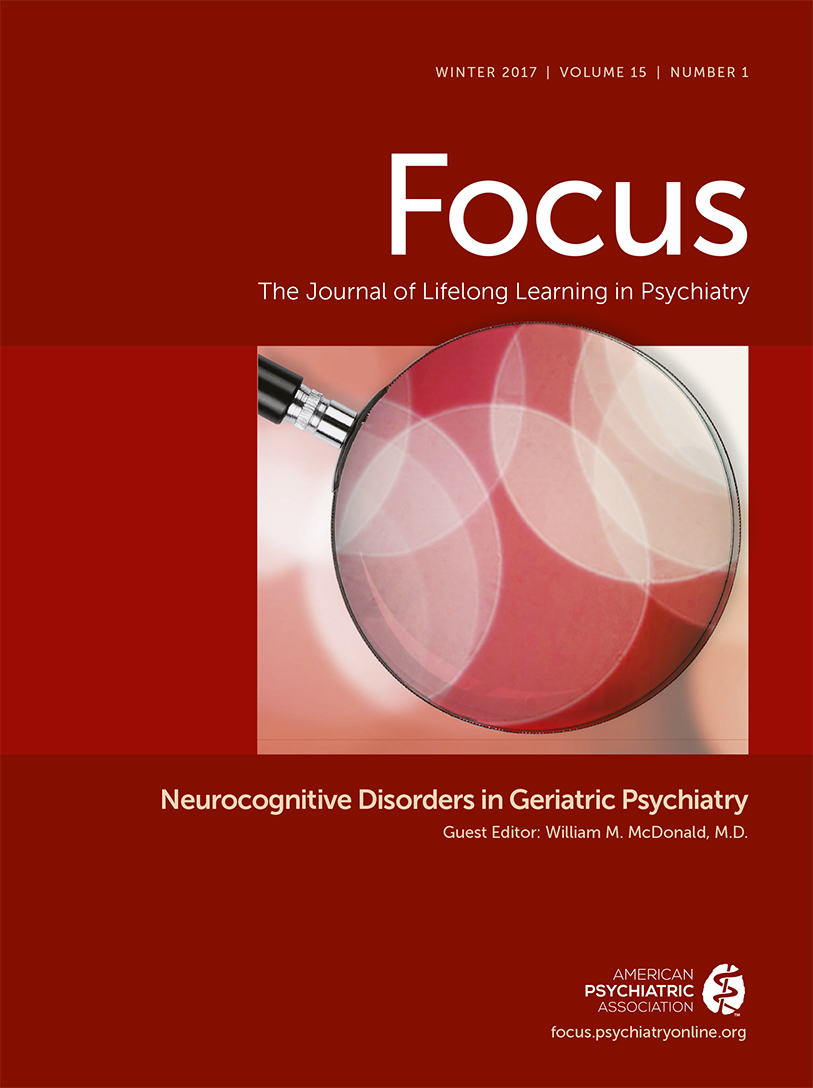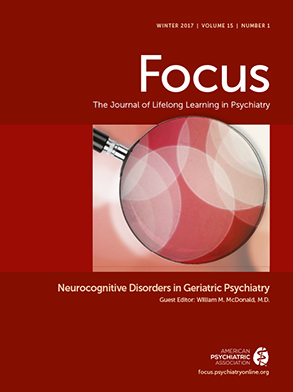The Clinical Interview
The cornerstones of assessing PD-related cognitive impairment are a thorough clinical interview, objective cognitive screening measures, and additional diagnostic studies as indicated. To guide the exam and differential diagnosis, the first step is to confirm the diagnosis of PD. Deviations from the usual PD motor syndrome should trigger considerations of other explanations for parkinsonism, cognitive changes, and psychiatric phenomena. Ask patients to describe their initial motor symptoms, how they evolved, progressed, and responded to medications, and their impact on ADLs and other daily activities. Typically, in idiopathic PD, the characteristic motor symptoms of resting tremor, slowness, and rigidity begin unilaterally and spread and progress bilaterally. A robust motor response to dopaminergic replacement therapy supports a diagnosis of idiopathic PD. With ongoing use, complications of dopaminergic medications include on-off motor fluctuations and hyperactive dyskinetic choreoathetoid movements that can resemble the movements of Huntington’s disease or tardive dyskinesia. Since PD is a progressive disease, alternative diagnoses are suggested when motor symptoms do not worsen over time or when the patient never requires higher doses of antiparkinsonian medications to control motor symptoms. Inability to adhere to the usual PD medication regimen of dosing several times daily may be indicative of cognitive impairment rather than a nonresponse to medications. While early-onset imbalance and falls are inconsistent with the diagnosis of PD, their later emergence is associated with development of PD-MCI and PDD.
Screening should include the full range of NPS, as they themselves may cause cognitive dysfunction as well as aid in distinguishing PD from other possible diagnoses. Red flags of cognitive dysfunction include fatigue, depression, apathy, psychosis or hallucinosis, bradyphrenia, medication nonadherence, and gait changes (
62,
63). Ideally, clinical interviews should be supplemented with information from one or more informants as the patient’s ability to provide an accurate history may be diminished due to cognitive impairment and because PD patients vary regarding their insight into NPS (
64). Because PD patients or their families also may not be aware that PD has cognitive manifestations or may attribute deficits or significant decline and disability to normal age-related changes, cognitive deficits may not be appreciated or reported (
22).
Assessment across the range of cognitive domains, including executive and visuospatial function, is essential in PD, as the typical “subcortical” pattern of deficits often does not include overt memory impairment as in AD. An important component of the clinical interview is to inquire about forms of cognitive dysfunction that occur in everyday life. First, determine when the patient or informant noted a change in the patient’s cognitive abilities compared with his or her adult baseline, the features of those initial changes (e.g., slowed thinking or trouble recalling names), how they progressed, and whether new difficulties emerged. In order to target interventions that are meaningful to the patient, it is often helpful to clarify the patient’s most bothersome deficits, the impact of those deficits on daily function, including employment and social activities, the effects of any prior interventions, including favorable or adverse effects of medications for PD or otherwise, and whether any compensatory strategies have been helpful.
When cognitive deficits are not mentioned spontaneously, the psychiatric interview of a PD patient should include inquiries about problems in everyday life that relate to cognitive dysfunction. These include gait and balance problems, which, as mentioned, are associated with PD-MCI and PDD. Executive functions, the mental processes related to the planning and execution of complex social and goal-directed behavior, are particularly affected in PD and influence compensatory strategies. As executive functions are context or task dependent, patients may not report troubles, especially if they have already ceased activities that tap executive functions, for example, set-shifting tasks such as paying the bills, taking part in group conversations, or driving. In PD, task and attentional demands during routine functions contribute to clinical symptoms and gait disturbances. For example, navigating through a crowded hallway while speaking with another person requires multitasking that may exceed the diminished cognitive capacity of a PD patient. Hence, patients use the expression that they “can no longer walk and talk at the same time.” The increased cognitive effort and the prospect of embarrassment because of difficulty or failure to complete tasks (or, simply, talk while walking) can cause increased stress and lead to significant anxiety, demoralization, and even social withdrawal because of anticipatory anxiety about encountering difficulties. Executive and attentional deficits further undermine the ability to ignore distractions and respond to the environment (i.e., selective attention and response inhibition), adjust actions and plans in response to new information (i.e., set-shifting and flexibility, such as moving aside or changing one’s path to avoid a collision or a fall), and develop and initiate a series of actions to achieve a desired goal (i.e., strategic planning) (
62). This interaction of mood, motor, and cognitive deficits was nicely demonstrated in a study in which PD patients and healthy control subjects performed tasks of increasing motor and cognitive complexity (simple walking, walking and carrying a tray, walking and recalling a memory, and walking while carrying a tray and recalling a memory) (
65). In that study, all participants, including controls, had reduced gait speed as the task complexity increased. However, greater reductions in gait speed were associated with cognitive deficits as well as with symptoms of depression, physical fatigue, and imbalance.
Deficits in other cognitive domains are frequently observable during the clinical interview. When patients are asked to describe their daily activities or medication regimens, slowness in the ability to process and respond to information presents as bradyphrenia, which affects speech latency, problem solving, and comprehension of information, especially of complex ideas. Language dysfunction may present as word-finding deficits or diminished spontaneity of speech. Even later in the disease, aphasia, agnosia, and apraxia are not as common or pronounced as they are in AD. Vague or discrepant answers raise the possibility of memory deficits. However, in PD, remote memory deficits present as relatively mild and subtle because memory encoding is relatively preserved until late in dementia, but retrieval of memories is impaired. Thus, in the context of a clinical interview with direct questioning, a patient’s relatively intact recognition memory (the ability to recall information when cued) may mask (or compensate for) impairments in explicit recall. Visuospatial dysfunction involves trouble perceiving, processing, discriminating, and acting on visual information in the environment. This affects navigation in the home, or from the waiting room to the office, or estimation of distances when reaching for objects, all of which can lead to falls, which are predictive of a transition to PDD.
Objective Cognitive Assessment Tools
As a minimum standard of care, American Academy of Neurology guidelines recommend formal evaluation of cognitive function initially and then at least annually along with documentation of memory and other cognitive complaints at every visit (
66). In clinical settings, the purpose of screening is to minimize false negatives (i.e., to maximize sensitivity so that individuals with the condition are not overlooked). At the bedside, it is ideal for clinicians to use a single tool that is easy to administer, has high sensitivity as a screening tool, and can be used longitudinally to detect conversion to dementia and monitor its progression. A full neuropsychological test battery is often unnecessary to diagnose PD cognitive syndromes but may be used to formulate a treatment plan, clarify relative strengths and vulnerabilities, and serve as a baseline to monitor longitudinal change.
Several brief cognitive screening instruments, validated for use in PD, are recommended for level I assessments to determine whether MDS criteria are met for PD-MCI or PDD (
67). For PD-MCI, the MDS Task Force originally recommended the Montreal Cognitive Assessment (MoCA), the Parkinson’s Disease-Cognitive Functional Rating Scale (PD-CRS), the Scales for Outcomes in Parkinson’s Disease-Cognition (SCOPA-COG), and the Mattis Dementia Rating Scale (MDRS) (
9). While these tests can result in misclassifications depending on cut-off scores, all perform sufficiently to assess the spectrum of cognitive domains and are sensitive to early stages of cognitive impairment (
68,
69). The SCOPA-COG and the PD-CRS (
http://www.movementscales.com/pd-crs-en-sp) were developed to tap cognitive domains relevant to PD, in contrast to the focus on memory abilities in generic assessment tools, and are sensitive to diagnoses of PD-MCI as well as PDD (
70).
Validation studies of the MDS-recommended criteria for PDD (
13) show that the MDS eight-item diagnostic checklist for PDD has high specificity but low sensitivity (
71) and may benefit from minor modifications to increase its sensitivity. The Mini-Mental State Examination (MMSE) is recommended as a screening tool for PDD but not for PD-MCI (
72). The MMSE has limited ability to detect executive function, and it is not uncommon for PDD patients to actually score in the normal range (≥26). The Clinical Dementia Rating Scale (CDR), developed initially for AD, distinguishes normal cognition, PD-MCI, and PDD when PD-specific cut-offs are used (
73). The PDD-Short Screen (PDD-SS), which combines components of the MMSE and the MoCA, has shown high sensitivity and specificity for PDD (
74).

